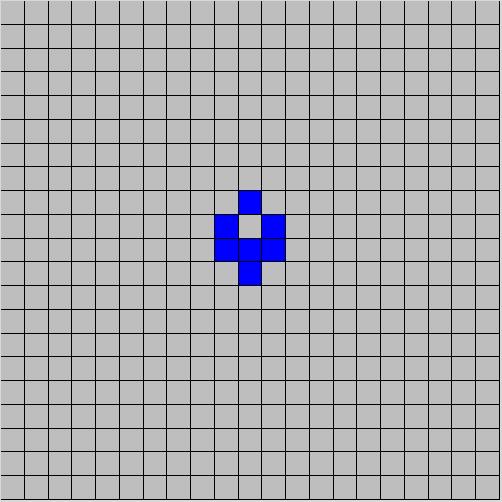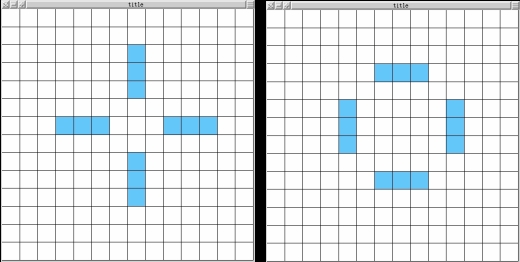CS21 Lab 12: The Game of Life Class
You may work with a partner on this assignment
Run update21, if you haven't already, to create the cs21/labs/12 directory. Then cd into your cs21/labs/12 directory and create the python programs for lab 12 in this directory (handin21 looks for your lab 12 assignments in your cs21/labs/12 directory):
$ update21 $ cd cs21/labs/12 $ ls grid.pyc $ vim gameoflife.pyWith update21 you received a file, grid.pyc, that is our solution to lab 11. You may use our solution if you did not completely solve lab 11.
If you did solve lab 11, it is likely better to use your own solution to it. Copy your grid.py solution from your labs/11 directory into your labs/12 directory and remove our grid.pyc file:
$ rm grid.pyc $ cp ../11/grid.py . $ ls gameoflife.py grid.py
For this assignment, you will implement a class, GameOfLife, that can be used to play John Conway's Game of Life. The GameOfLife class will use the Grid and Cell classes you wrote for lab 11.
The Game of Life simulates evolution of a cellular automata in a 2-D world. At each time step in the simulation, a cells either lives or dies based on its state and the state of its neighbors. In this game after an initial configuration of the world's cells are set, then at each time step a cell's state changes according to the following rules:
- For a cell that is 'alive' or 'populated':
- if it has only one or no live neighbors, it dies from loneliness
- if it has four or more live neighbors, it dies due to overpopulation
- if it has two or three live neighbors, it lives
- For a cell that is 'dead' or 'unpopulated'
- if three of its neighbors are alive, it becomes populated
- You must implement a GameOfLife class that has a Grid data member. You may add additional data members as you like.
- Your GameOfLife class should have at least these methods (you may add
more if you'd like):
- __init__(row, cols): will create a new GameOfLife object and create its Grid object data member with the passed number of rows and cols.
- close(): will invoke the Grid's close method that will not close the graphics window until the user clicks on it.
- startRandomGame(): creates a starting point world where Cells are randomly selected to be live or dead
- startWalkerGame(): creates a starting point world of the walker pattern in the lower left corner (see the Sample output section for what this pattern should look like))
- startExpanderGame(): creates a starting point world of the expander pattern such that it is drawn CENTERED in the world grid (see the Sample output section for what this pattern should look like)
- playGame(num_steps): play the game of life on the current world state for num_steps time steps (see the rule of the game of life above). Use the sleep function to sleep some number of tenths of a second between each time step
- The constructor to the GameOfLife class should take the number of rows and columns in the world
- You should write a main program that prompts the user to enter the
number of rows and columns in the world, then creates a GameOfLife object
of the given dimensions. For each of the game starting points
(random, walker and expander) in turn your program should:
- call the startX method to initialize initialize the world for the appropriate game of life
- prompt the user to enter the number of time steps to simulate this game
- play the game of life
if __name__ == '__main__':
main()
To the top of your gameoflife.py file, import classes from grid.py:
from grid import *or to just import the Grid and Cell class definitions:
from grid import Grid from grid import CellIf you use our starting point solution to grid (in grid.pyc that you grabbed with update21), then you can see the interface to it by doing the following:
$python >>> from grid import Grid >>> from grid import Cell >>> help(Cell) >>> help(Grid)
$ python gameoflife.py This program plays Conway's Game of Life Enter number of rows in the grid: 21 Enter number of cols in the grid: 21

Enter the number of steps to run the random game: 30

Enter the number of steps to run the walker game: 50

Enter the number of steps to run the expander game: 20
Click to exit

Here are some ideas for extensions:
- Add other starting point methods that initialize the world
to different configurations. There are many that will lead to
interesting patterns that move across the space in some way that
converge to a static pattern in some way. Look on-line for some
examples.
- Modify the Grid and Cell class so that a user can use mouse clicks
to turn cells ON or OFF to set a starting pattern for each game.
If you do this extension, submit two solutions: gameoflife.py with the basic assignment; and gameoflife_ex2.py with this version.
I have not done this extension, so I don't have an idea of how difficult it is, but I suspect that it will require a significant amount of effort. I think the best way to try this is to add another row of buttons to the graphics window that have functionality such as start, stop, clear and quit. The user would then choose clear to clear the grid, click on individual grid cells to turn them ON or OFF, and then choose start to start the game of life simulation, and stop to stop it. The quit button could close the game.
Once you are satisfied with your program, hand it in by typing handin21 in a terminal window.